|
CHINA SCIENCE AND TECHNOLOGY
NEWSLETTER
The Ministry of Science and Technology
People's Republic of China
|
|
|
N0.513 |
June 10,2008 |
|
|
|
|
|
|
|
|
IN THIS ISSUE
|
|
* China-Korea Polar Cooperation
* International S&T Cooperation Award-07 Honored
* Two More Earth Satellites
* Cholesterol Absorbing Mechanism Unveiled
* First HRPT Cloud Image from FY-3 Weather Satellite
* National Platform for Chinese Genetic Resources
|
|
INTERNATIONAL COOPERATION |
China-Korea Polar Cooperation

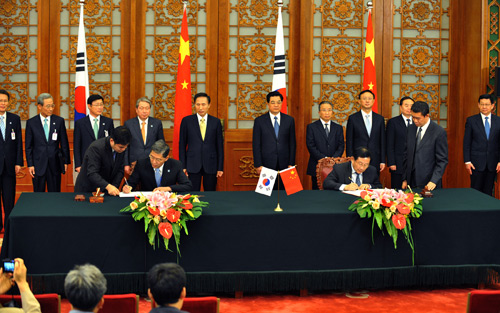
WAN Gang, Chinese Minister of Science and Technology, and Kim Doh-Yeon, Korean Minister of Education, Science and Technology jointly inked on May 27, 2008 an MOU on polar S&T cooperation at the Great Hall of the People. Chinese President HU Jintao and the visiting Korean President Lee Myung-bak were present at the signing ceremony. Both parities agreed to strengthen collaborations in the area of polar science and technology through joint studies, information sharing, and personnel exchange, in an attempt to protect earth ecology and respond to climate change.
International S&T Cooperation Award-07 Honored
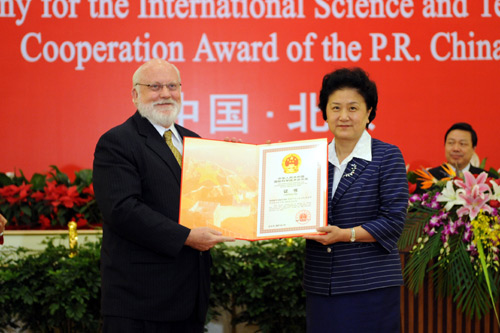
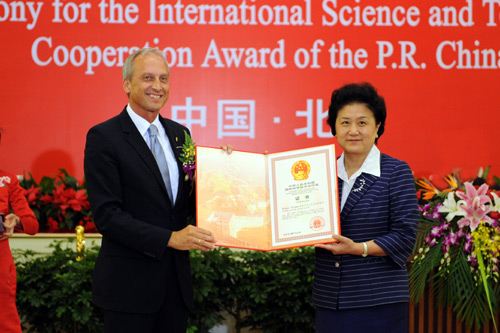
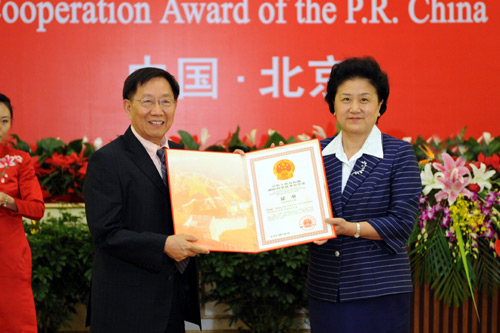
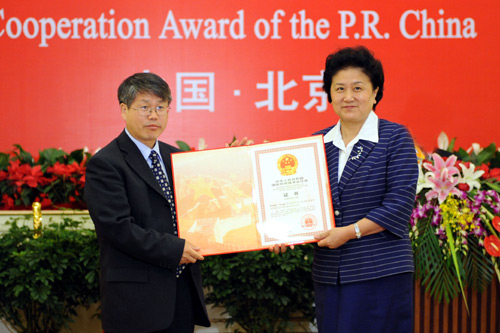
China International S&T Cooperation Award-07 was conferred on June 5, 2008 in Beijing. LIU Yandong, Chinese State Councilor, presented medals and certificates to the winners from the UK, the United States, Germany, and International Rice Institute, on behalf of the Chinese government. WAN Gang, Chinese Minister of Science and Technology, spoke at the ceremony. He sent his congratulations to the winners, and thanked them for promoting China’s international S&T cooperation, and for their contributions to China’s S&T development. Heads from other involving government agencies, and officials from the British, German, and American embassies in Beijing were also present at the event.
Two More Earth Satellites
The 5th China-Brazil meeting on earth resources satellite was convened on June 3, 2008 at the Brazilian Space Institute, to celebrate the 20th anniversary of space cooperation between the two countries, review the work progresses of both earth resources satellites III and IV, and discuss the upcoming cooperation events, including satellite V and VI in the series. Both parties signed a summary report at the end of the meeting. Heads of space technology institutes in both countries expressed their thanks to the scientists who have made contributions to the project, hoping more collaborations in next 20 years and more. Both parties thought highly of the project as a role model for South-South S&T cooperation, and aired their satisfactions to the results achieved at the meeting, expecting more fruitful cooperation in the future.
Cholesterol Absorbing Mechanism Unveiled
SONG Baoliang and coworkers at Institute of Biochemistry and Cell Biology, CAS Shanghai Institutes for Biological Sciences, have found a Niemann-Pick C1-like 1 (NPC1L1) that plays a critical role in cholesterol absorption. They found that cholesterol specifically promotes the internalization of NPC1L1, and that this process requires microfilaments and the clathrin/AP2 complex. They also shed light on the action of the drug Ezetimibe (trade name Zetia), which is used to treat high cholesterol. They believe that Ezetimibe prevents NPC1L1 from incorporating into clathrin-coated vesicles, and thus inhibits cholesterol uptake. The finding, published in the June 4th issue of Cell Metabolism, unveils the molecular path of cholesterol absorption, and creates new theoretical evidences and experimental basis for screening out new cholesterol inhibitors.
Treating Marine Organisms Using Flocculants
A study team, led by Prof. DING Yongsheng at Shanghai Maritime University Institute of Marine Environment and Engineering, has developed an inorganic polymer composite flocculant that is able to perform a quick test of marine organisms in confined water, and a nano flocculant capable of preventing the intrusions of hazardous marine organisms. The new technologies have provided a novel approach for protecting marine environment.
Researchers in the project developed inorganic polymer composite flocculants with the capability of capturing the organisms having a cell concentration lower than 10/mL, based on which they produced a nano flocculant that is able to kill hazardous marine organisms. Both technologies, effective and fast, have been applied to killing the microorganisms in the confined water in a boat environment. It is most desirable for killing tiny microorganisms (eggs and spores) that cannot be separated using other technical means.
China’s First White Light Lidar
A white light lidar, developed by CAS Wuhan Institute of Physics and Mathematics, has recently passed experts’ test. According to a briefing, the new lidar makes space sounding of atmospheric medium spectrum, utilizing the effects of super continuous spectrum radiation produced by high power femtosecond laser. It has combined the strength of both wide spectrum sensitivity of differentiated white light absorption and high space resolution of femtosecond lidar, allowing improved atmospheric sounding with real-time spatial, temporal, and spectrum resolutions, compared with conventional lidar. The system, though experimental in nature, is China’s first unit designed to study high power femtosecond transmission, continuous white light mechanism, and novel approaches for atmospheric sounding.
Acoustic System for Deep Sea Cables
In collaboration with Yadi Technology (Shanghai) and CSIC No.702 Institute, it takes 6 years for researchers at CAS Institute of Acoustics to work out a proprietary DTA-4000 acoustic deep drag system. Equipped with a high resolution deep scanning sonar, the new system works with an innovative approach to process the signals on sea floors, or a multiple sub-array automatic scanner, allowing a greatly enhanced performance and reduced power consumption, with a maximum work depth approaching 4000m.
The new system was recently employed to examine optical cables as long as 640 km on the sea floor for 145 hours, with the longest continuous operation for 116 hours. The operation has produced reliable data on sea floor terrains and acoustic sections, though in a rough sea condition.
Improved High Oil Corn
Based on 12-year painstaking efforts, a study team, led by FAN Xingming, a research fellow with the Yunnan Academy of Agricultural Sciences, has bred out Yunrui-21, a novel tropical high oil corn species desirable for growing in the locality, taking advantage of the combined strength of SSR technology and conventional breeding techniques. Test results produced by Ministry of Agriculture Grain Quality Control Center show that the corn, containing a crude fat of 6.06%, crude starch 72.25%, crude protein 7.66%, and lysine 0.31%, is the first domestic high oil corn species up to a high starch criterion. Meanwhile, the Institute of Crop Germplasm Resources, part of the Chinese Academy of Agricultural Sciences, has confirmed that the new species is of a strong resistance to major corn diseases, including leaf blight, gray leaf spot, silk head smut, spike rot, and dwarf mosaic. The new species has been placed under protection since 2007 as a national new plant species.
Up to date, the high oil corn has been grown over an area of 1.8182 million mu (1 mu= 0.0667 hectare) on a combined basis, with an increased yield of 118,800 tons, and an averaged yield of 586.1kg per mu. It has become an effective solution to addressing the low yield of high oil corn grown in the country, with a direct and indirect output worth RMB 480 million. Experiments in Yunnan Province have shown that the feeds with Yunyou-21 as a main ingredient produce 33.55% more meat in pigs, compared with conventional corn feeds. It is a promising corn feed for increasing meat production in the poverty-stricken areas, and adds more nutrition to the corn consumed by people as a stable food.
First HRPT Cloud Image from FY-3 Weather Satellite

A cloud image sent back by FY-3.
A Guangzhou weather satellite ground station successfully received HRPT cloud images from a FY-3 weather satellite at 10:16 a.m. May 29, 2008. FY-3A weather satellite marks a transition from pure remote sensing to an integrated earth environment sounding, enjoying four major technology breakthroughs from optical sounding to microwave sounding, from a resolution at the kilometer level to a hundred meter level, and from domestic reception to polar reception. Equipped with diverse sounding instruments, the new satellite is able to monitor both earth atmosphere and ecological environment in an all-weather, global, multi-spectrum, and 3-D manner. According to the work schedule, researchers will open up 11 remote sensing and sounding instruments aboard the satellite in the coming 5 weeks, allowing a 4-month in-orbit test before putting them into operation.
National Platform for Chinese Genetic Resources
China has established a national platform to study Chinese genetic resources and to provide needed services in the area. A website (www.egene.org.cn) was put into official operation on September 25, 2007 for the purpose. As of January 23, 2008, 424,725 people have visited the website. The platform is currently working on more service items, including a catalog for Chinese genetic resources, portal navigation, and service recommendations. In the upcoming secondary development, the platform will introduce SOA based multi-tiered structures for resources consolidation, and employ both ISO9000 and ISO20000 accreditation systems to ensure quality service.
More Chinese Genetic Resources Shared
Thanks to its good intention to share both materials and specimens of Chinese genetic resources, China has allowed, as of December 2007, some 70,360 Chinese genetic resources being shared. In 2007, a range of research findings achieved through sharing Chinese genetic resources were published in international journals, or presented at international meetings. For example, a paper on Chinese male prostate tissues miRNA125 and its male hormone regulation was published in the Proceedings of the National Academy of Sciences, and a paper studying crystal protein mutation using family cataract information reported its results in Human Mutation. In 2007, the sharing project has led to the publication of 32 papers cited by SCI and 4 invention patents.
Streptococcus Suis Better Understood
WANG Xiaoning and coworkers at South China University of Technology have made a breakthrough in understanding a signal-transduction system that is crucial for the virulence of highly invasive Streptococcus suis. The finding was published in the recent issue of Public Library of Science One (PLoS One). By comparing genomic sequences of various bacterial strains, researchers identified a putative pathogenic island that is unique to the two SS2 strains isolated from Chinese patients. WANG and co-workers found that, unlike their wild-type counterparts, SalK/SalR-lacking bacteria were not capable of colonizing, and thereby infecting piglet tissues. By comparing gene expression in wild-type and SalK/SalR-lacking bacteria, researchers identified the genes that were down-regulated in the mutant, which could serve as leads for further characterization of SS2 virulence.
High Definition Eyeground Image Compensator
CAS Changchun Institute of Optics, Fine Mechanics, and Physics has recently rolled out a high definition eyeground image compensator that has passed experts’ approval. With a compensation resolution of 3 microns and a depth of 10 microns, the new instrument is able to perform no-injury imaging tests on highly advanced short-sighted patients. Researchers realized the self-adaptive depth compensation, using a deformable mirror correction technique, taking into account the optical properties of both human eyeground and laser source. In the course of working on a simple, convenient, safe, and evenly distributed eyeground imaging system, researchers have produced 5 invention patents, and 16 papers on the technology.
Painted Stork Found in Guizhou
Not long ago, people found 13 painted storks, or Mycteria leucocephala, in the Guizhou Caohai National Nature Conservation Zone. Scientists have confirmed that the birds discovered in the zone are a rare species that has not been reported for more than 50 years.
With a length of 93—102cm, and a weight of 2—3.5kg, the painted stork in beautiful feathers has a thick and long bright yellow bill with a slightly inclined tip, making it different from other storks. As a migrant bird, the painted stork used to live in the coastal areas of Hebei, Shanghai, Jiangsu, Fujian, Guangdong, Hainan, Sichuan, Yunnan, Tibet, and the lower reach of the Yangtze River. A painted stork usually can live as long as 28 years.
Comments or inquiries on editorial matters or Newsletter content should be directed to:
Mr. XU Chaoqian, Department of International Cooperation, MOST 15B, Fuxing Road, Beijing 100862, PR China Tel: (8610)58881360 Fax: (8610) 58881364
http://www.most.gov.cn |

